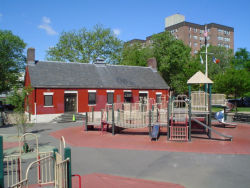Newtown Playground
Newtown Playground
What was here before?
This site was originally used as a cemetery, known as Old Newtown Cemetery or the Ancient Burial Ground. The early history of the site is not well documented, but it likely came into use shortly after the settlement was founded, making it the first community burial ground in Newtown. Many noted early settlers of Newtown and later generations were buried here including the settlements’ founder Reverend John Moore (1620-1657). Prominent colonial settlers and their families buried here included members of the Burroughs, Coe, Fish, Lawrence, Moore, Sackett ,and Titus families.
From around 1850 onward, it was used as a potter’s field for African American and European American townspeople. In 1891, it was closed and cleaned up but by 1897, the grounds were again in poor condition.
How did this site become a playground?
In 1898, the newly consolidated City of New York acquired the land and placed it under control of the Department of Parks in 1917, which developed the playground in 1934 and opened it the following year.
The playground was redesigned and updated in 1997 with open lawns over archeologically sensitive areas, the original cemetery wall was reconstructed with traditional materials, and weeping cherry and beech trees were planted.
The city completed a renovation in 2019 with graceful paths and contemplative seating areas, along with careful plantings that were created over the archaeologically sensitive section of the park. This park serves as a memorial and resting place to the settlers, their families, and nameless African and European Americans of Newtown who helped build this community.
Who is this playground named for?
This playground takes its name from one of the oldest European settlements in Queens.
In 1652, Reverend John Moore led a group of 54 English Colonists seeking a place to settle for religious freedom with permission from Governor Peter Stuyvesant (1592-1672). They created their settlement in what is now Queens Boulevard and Broadway. The Horse Brook Creek, which flowed through the area, was a vital reason the early colonists chose to settle here.
In 1656, the land for the new colony was formally obtained by a deed from two Native Americans named Rowerowestco and Pomwaukon, by the original English colonists giving the rate of a shilling per acre. The settlers named this location Middelburgh to honor a town in Holland that allowed expression of religious freedom. When the English system of towns and counties was introduced in 1683, the community was designated as Newtown.
Newtown lent its name most prominently to an apple and a waterway. The Newtown Pippin originated on the Moore family estate (now the Moore Homestead Playground) on the farm of Gershom Moore in the late 17th century.
Real estate magnate Cord Meyer Jr. developed Newtown from a farm village to an upscale planned community. Since the far distant Newtown Creek became so foul and polluted, Meyer wanted to dissociate from the name Newtown. In 1895-96, he successfully lobbied the U.S. Postmaster General to change the historic town’s name to Elmhurst.
Check out your park's Vital Signs
Clean & Safe
Green & Resilient
Empowered & Engaged Users
Share your feedback or learn more about how this park is part of a
Vital Park System



